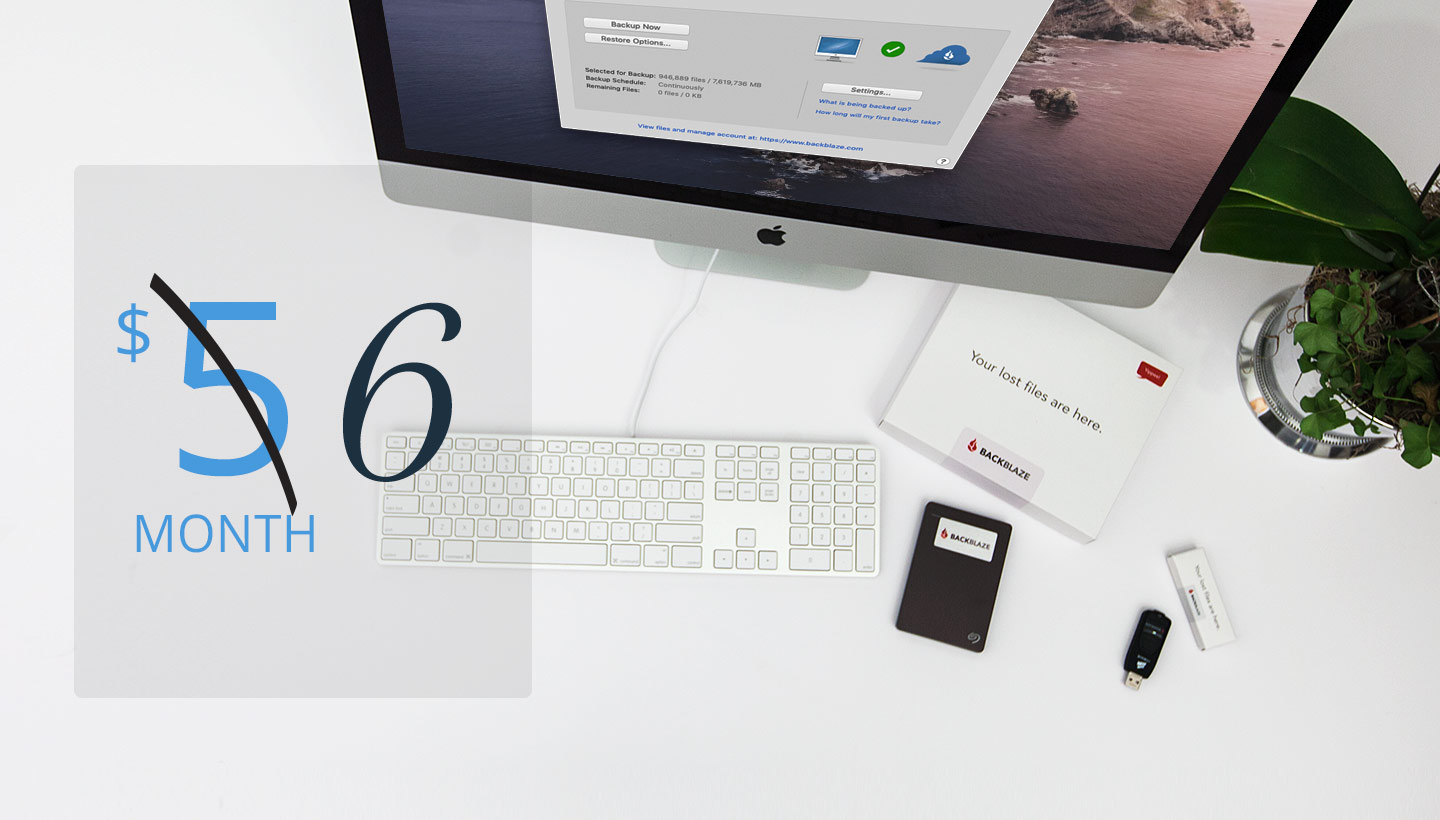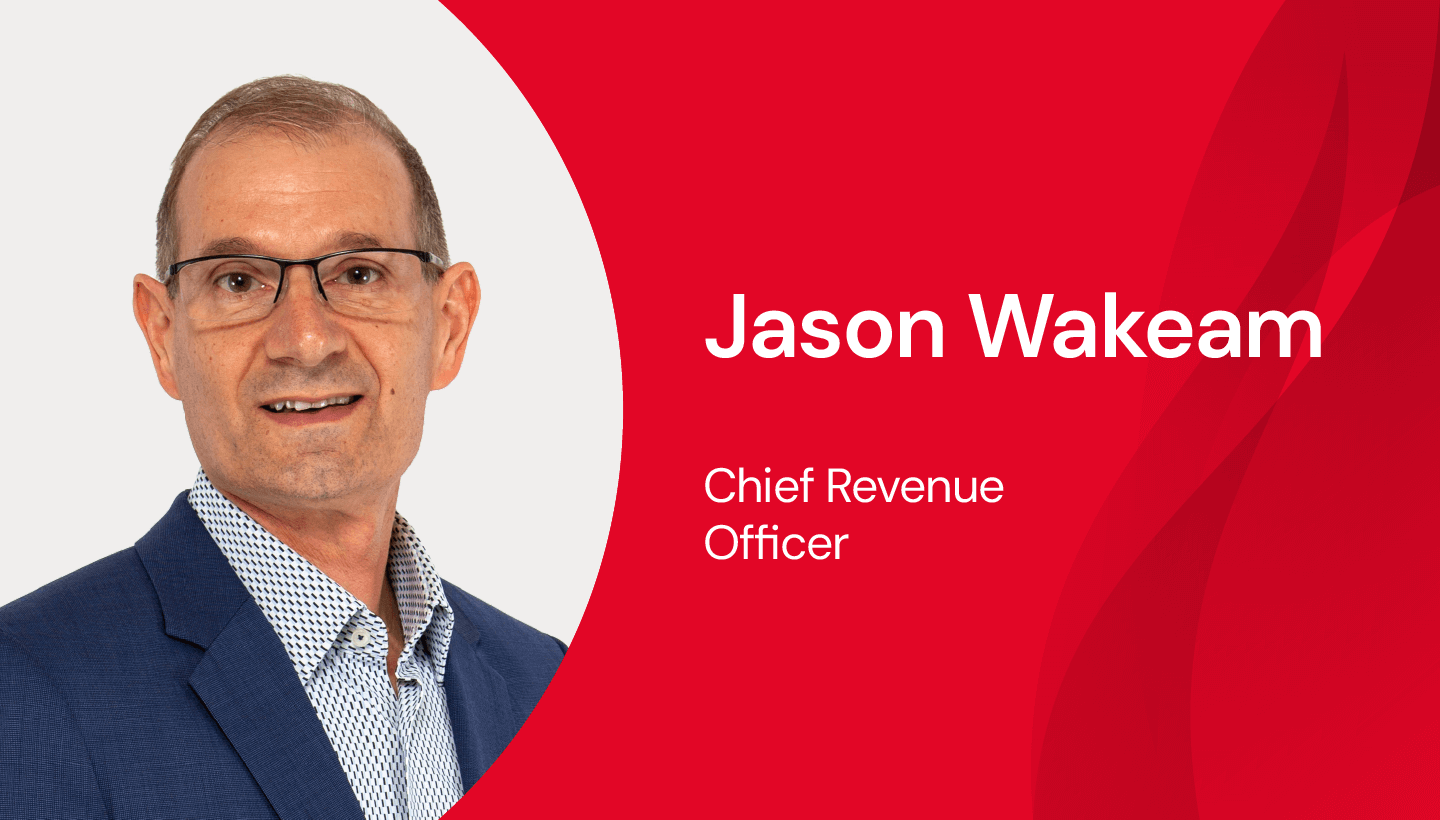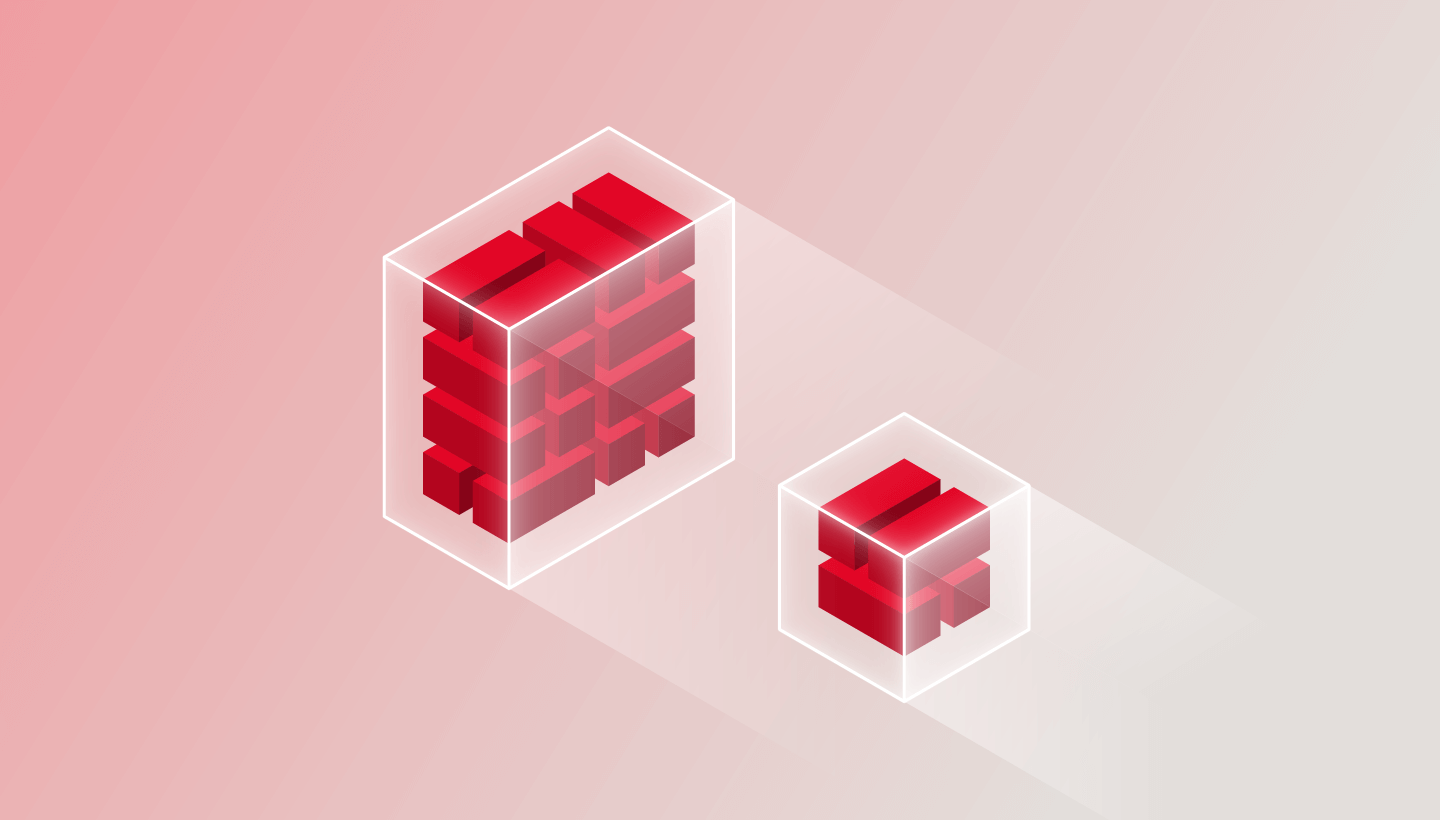Raising prices should not be an 18-month project.
Everyone is faced with the decision to raise prices at some point. It sucks, but in some cases you have to do it. Most companies, especially SaaS businesses, will look at their revenue forecasts, see a dip, run a calculation predicting the difference between the revenue increase and how many customers might leave, and then raise prices if the math looks favorable. Backblaze is not most companies — here’s how we did it.
In February of 2019, we made the announcement that one month later, our prices for our Personal Backup and Business Backup services would be going up by $1: our first price increase for our Computer Backup service since launching the service over a decade ago. What was announced in February 2019 actually started in December 2016, more than two years before the actual price increase would take effect. Why the long wait? We wanted to make sure that we did it right, not just mechanically (there’s a lot of billing code that has to change), but also in how we communicated to our customers and took them through the process. Oh, and a big reason for the delay was our main competitor leaving the consumer space, but more on that later.
In this post I’ll dive in to our process for how we wanted the price increase to go, why we decided to build the extension program for existing customers, what went in to our communication strategy, and what the reactions were to the price increase, including looking at churn numbers.
Is Raising Prices a Smart Move?
Raising prices, especially on a SaaS product where you’ve built a following, is never an easy decision. There are a ton of factors that come into play when considering what, if any, is the best course of action. Each factor needs to be considered individually and then as a whole to determine whether the price increase will actually benefit the business long term.
Why Raise Prices?
There are many reasons why companies raise prices. Typically it’s to either increase revenue or adjust to the market costs (the total cost associated with providing goods or services) in their sector. In our case it was the latter. In the price increase announcement, we discussed our reasoning in-depth, but it boiled down to two things: 1) adjusting to the market cost of storage (it was no longer decreasing at the rate it was when we first launched the product), and 2) we had spent years enhancing the service and making it easier for people to store more and more data with us, thereby increasing our costs.
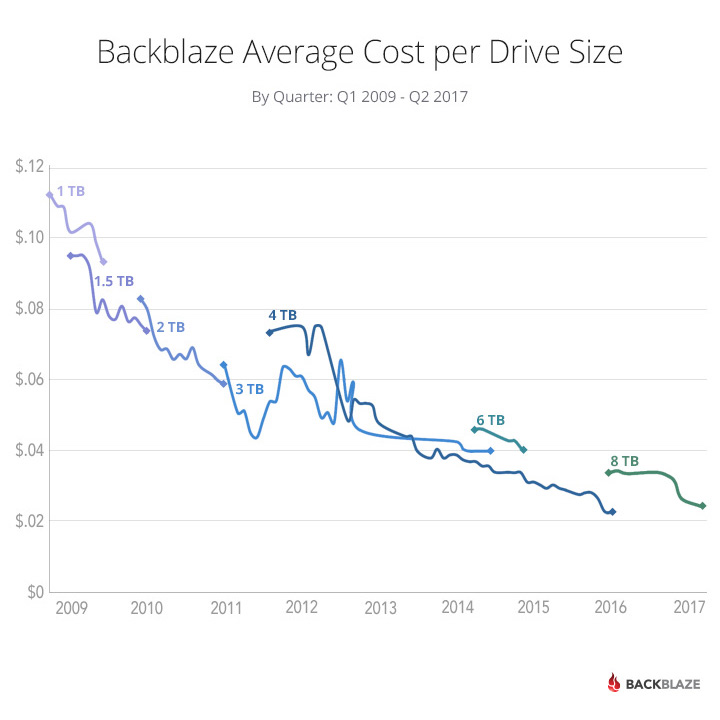
One of the core values of Backblaze is to make backup astonishingly easy and affordable. Maintaining a service that is easy to use, has predictable pricing, and takes care of the heavy lifting for our customers was and is very important to us. When we started considering increasing prices we knew that we were going to be messing with the affordable part of that equation, but it was time for us to adjust to the market.
How to Raise Prices?
Most companies say that they love their customers, and many actually do. When we first started discussing exactly how we were going to raise prices we rejected the easiest path, which was to create a pricing table, update the website, and flip a switch. That was the easy way, but it was important for us to do something for the customers who have trusted us with their important files and memories throughout the years. We would still need to build out the pricing table (fun fact: from 2008 to 2017 our prices were hard-coded) but we started thinking about creating an extension program for our existing customers and fans.
The Extension Program
The extension program was a way for existing Backblaze users to prepay for one year of service, essentially delaying their price increase. They would buy 12 months of backup credits for $50 for each computer on their account, and after those credits were used up, the new prices would go into effect on their next renewal. It was a way to say thank you to our existing customers, but there was just one problem — it didn’t exist.
Building the extension program became a six month project in and of itself. First we needed to build a crediting system. Then, we needed to build the mechanism for our customers to actually buy that block of credits and have them applied to their account. Afterwards, we’d need FAQs, confirmation emails, and website changes to help explain the program to our customers. This became a full-time job for a handful of our most senior engineers, and resulted in a six month project before we were ready to put it through our QA testing. The long development time of the project was a large point of consideration, but there were also financial implications that we had to consider.
The extension program was great for customers, but good/bad for Backblaze. Why? By allowing folks to sign up for an extension we were essentially delaying their price increase, therefore delaying our ability to collect the additional revenue. While that was not ideal, the extension program brought in additional revenue from people purchasing those extensions, which was good. However, since those purchases were for credits, that additional revenue was deferred, and we still had to provide the service. So, while good from a cash flow perspective (we moved up about $2M in cash), we had to be very careful about how we accounted for and earmarked that money.
Continuing to Provide Value
Extensions were only part of the puzzle. We didn’t want customers to feel like we were simply raising prices to line our pockets. Our goal is to continue making backup easy and affordable, and we wanted to show our fans that we were still actively developing the service. The simplest way to show forward progress is to make…forward progress. We decided that before the announcement date we needed to have a product release that substantially improved the backup service, and that’s when we started to plan Backblaze Version 5.0, what we dubbed the Rapid Access Release.
Adding to the development time of creating extensions were the projects to speed up both the backup and restore functions of the Backblaze app (those changes were good for customers, but actually increased our cost of providing the service). In addition, customers could now preview, access, and share backed up files by leveraging our B2 Cloud Storage product. To top it off we strengthened our security by adding ToTP as a two-factor verification method. All those features were rolled up into the 5.0 release and were released a few weeks before we were set to announce our price increase, which was scheduled to be announced on August 22nd, 2017.
Oversharing
Another of our core values is open communication, which we equate to being as open as possible. If you have followed Backblaze over the years, you know that we’ve open-sourced our storage pod design, shared our hard drive failure statistics, and have told entertaining stories about how we survived the Thailand drive crisis, and the time we were almost acquired. Most companies would never talk about topics like these, but we don’t shy away from hard conversations. In keeping with that tradition, we made the decision to be honest in our announcement about why we were raising prices (market costs and our own enhancements). We also made the decision to not mention one valid reason: inflation.
Our price back in 2008 was $5/month. With the inflation rate, in 2019 that would be around $5.96, so our price increase to $6 was right in-line with the inflation rate. So why not talk about it? We wanted the conversation to be about our business and the benefits that we’re providing for our customers in building a service that they feel is a good value. Bringing up global economics seemed like an odd tactic, considering that we weren’t even keeping up with inflation and ultimately customers got there on their own.
Lol, you guys kill me. A $1 price increase over 10 years? You aren’t even keeping up with inflation 😂
— John A. Fredrickson (@jfredson) February 13, 2019
When reading @backblaze blog post justifying their price increase you would think they were changing dramatically, an increase of $1 / month since 2008 barely exceeds inflation for a service that keeps getting better!
— Mikie 🇪🇺 (@mikieos) February 14, 2019
Disaster and Opportunity Strike
We started down the increase path in 2016. In 2017, we designed and released version 5.0, we built and tested our extension program, we lined up our blog post, we wrote up FAQs, and we created customer service emails to let people know what was happening. After all that, we were ready to announce the following month’s price increase at 10am Pacific Time on August 22nd, 2017.
On August 22nd, at 8am, we pulled the plug and cancelled the announcement.
What Happened?
Early that morning news broke that our main competitor, Crashplan, was leaving the consumer backup space. You may be saying: Wait a minute, a main competitor is leaving the market and you have a mechanism to increase your prices in place — that sounds like the perfect day to raise prices! Nope. Another one of our values, is to be fair and good. Raising prices on a day when consumers found out that there were fewer choices in the market felt predatory and ultimately gross. Once we saw the news, we got in a room, quickly decided that we couldn’t raise prices for at least 6 months, and instead we would write a quick blog post inviting orphaned customers to give us a try.
The year following Crashplan’s announcement we saw a huge increase in customers, which is simultaneously good and bad. It was good because of the increased revenue from our newfound customers, but less ideal from an operations perspective, as we were not anticipating an influx of customers. In fact, we were anticipating an increase in churn coinciding with our cancelled price increase announcement. That meant we had to scramble to deploy enough storage to house all of the new incoming data.
We wouldn’t revisit the price increase until a year after the Crashplan announcement.
That decision was not without financial repercussions. Put simply, we gave up $10 per customer per year. And, the decision affected not only our existing customers on August 22nd, but also all of those we would gain over the coming months and years. While this doesn’t factor in potential churn and other variables, when the size of our customer base is fully accounted for, the revenue left on the table was significant. In purely financial terms, raising prices on the day when the industry started having fewer options would have been the right financial decision, but not the right Backblaze decision.
Hindsight Is 20/20
Looking back, releasing version 5.0 earlier that month was a happy accident. What originally was intended to show forward progress to our existing customers was now being looked at by a lot of new customers and prospects as well. The speed increase that we built into the app as part of the release made it possible for people exiting Crashplan’s service to transition to us and get fully backed up more quickly. Because these were people who understood the importance of keeping a backup, having no downtime in their coverage was a huge benefit.
Picking Up Where We Left Off — The Price Increase
Around August of 2018, we decided that enough time had passed and we were comfortable dusting off our price increase playbook. The process proved harder than we thought as we uncovered edge-cases that we had missed the first time around — another happy accident.
The Problem With Long Development Gaps
The new plan was to announce the price increase in December and raise prices in January 2019. When we started unpacking our playbook and going over the plan, we realized that the simple decisions we had made over a year ago were either flawed or outdated. A good example of this was how we would treat two-year licenses. At one point in the original project spec, we decided that we were simply going to slide the renewal date by one year for anyone with a two-year license that purchased an extension, pushing their actual renewal date out a year. Upon thinking about it again, we realized this would cause a lot of customer issues and had to re-do the entire plan for two-year customers, a large part of our install base.
While we did have project sheets and spec documents, we also realized that we had lost a lot of the in the moment knowledge that comes in project development. We found ourselves constantly saying things like, “why did we make this choice,” and “are we sure that’s what we meant here?” The long gap between the original project start date and the day we picked it back up meant that the ramp-up time for the extension program was a lot longer than we expected. We realized that we wouldn’t be able to announce the price increase in December, with prices going up at the start of the year: we needed more time, both to QA the extension program and create version 6.0.
Version 6.0
Part of the original playbook was to provide value for customers by releasing version 5.0, and we wanted to stick to the original plan. We started thinking about what it would take to have another meaningful release and version 6.0, the Larger Longer Faster Better release was born.
First, we doubled the size of physical media restores, allowing people to get back more of their data more quickly and affordably (this was an oft-requested change, and one that is an example of a good-for-the-customer feature that incurs Backblaze extra costs). We leveraged B2 Cloud Storage again and built in functionality that would allow people to save their backed up data to B2, building off of the previous year’s preview and share capabilities. We made the service more efficient, increased backup speeds again, and also added network management tools. Looking past the Mac and PC apps, we also revamped our mobile offerings by refreshing our iOS and Android apps. All of that added development time again, and our new time table for the price increase was a February 2019 announcement, with the price increase going into effect in March.
Wait a Minute…
You might be saying, you released version 5.0 in a run-up to a price increase, then scrapped it, and then released version 6.0 in a run-up to a price increase. Does that mean that every new version number increase will be followed by a price increase? Absolutely not. The first five versions of Backblaze didn’t precipitate a price increase, and we’re already hard at work on version 7.0 with no planned price increases on the horizon.
Price Increase Announcement
We’ve all been subjected to price increases that were clandestine, then abruptly announced and put into effect the same day, or were not well explained. That never feels great and we really wanted to give customers one month of warning before the prices actually increased. That would give people time to buy the extensions that we worked so hard to build. Conversely, if people were on monthly licenses, or had a renewal date coming up after the price increase went into effect, it would give them an opportunity to cancel their service ahead of the increase. Of course we didn’t want anyone to leave, but realized that any change in our subscription plans would cause a stir and people who were more price-sensitive would likely have second thoughts about renewing.
Another goal was to be as communicative as possible. We wanted our customers to know exactly what we were doing, why we were doing it, and we didn’t want anyone to fall through the cracks of not knowing that this was happening. That meant writing a blog post, creating emails for all Personal Backup customers and Group administrators, and even briefing some members of the press and reviews sites who’d need to update their pricing tables. It might seem silly to pitch the press on a price increase (something that is usually a negative event), but we’ve had some wonderful relationships develop with journalists over the years and it felt like the right thing to do to let them know ahead of time.
Once all of those things were in back in place, it was time to press go, this time for real. The price increase was announced on February 12th and went into effect March 12th.
The Reaction & Churn Analysis
Customer Reaction — Plan for the Worst, Hope for the Best
We didn’t expect the response to be positive. Planning is great, but you never know exactly what’s going to happen until it’s actually happening. We were ready with support responses, FAQs, and a communications plan in case the response was overwhelmingly negative, but were lucky and that didn’t turn out to be the case.
Customers wrote to us and said, finally. Some people went out of their way to express how relieved they were that we were finally going to raise prices, concerned that we had been burning cash over the years. Other sentiments made it clear that we communicated the necessity for the increase and priced it correctly, saying that a $1 increase after 12 years is more than fair.
@GlebBudman Thanks for explaining so clearly and respectfully to your customers online. I am OK with the price increase. A healthy @backblaze means a healthy location for my backups. Well worth the price.
— Stephen Bubanovich (@sbubanovich) February 12, 2019
Just got the nice email from @backblaze CEO regarding the price change. $1 increase per month. If they had increased it $5 I still would pay. Great product! pic.twitter.com/QiD6igheua
— Chris McGuire (@chrisonhismac) February 12, 2019
@GlebBudman As a @backblaze customer since May, 2015, I received the notice today of the product price increase by $1 per month to $6. A very fair price adjustment for the service your company provides. No worries. Thank you for such an excellent product. – David | Boston, MA
— David Fitzgerald (@dff100) February 12, 2019
When the press picked up the story, they had similar sentiments. Yes, it was news that Backblaze was increasing prices, but the reports were positive and very fair. One of the press members that we sent the news to early responded with: “Seems reasonable…”
There were of course some people who were angry and annoyed, and while some of our customers did come to our defense, we did see an increase in churn.
Churn Rate Analysis
Over the next few months we monitored churn carefully to see the true impact on our existing customers from the price increase.
Every time a person leaves Backblaze we send one final email thanking them for their time with us, wishing them well, and asking if they have any feedback. Those emails go directly into our ticketing system where I read all of them every month to get a picture of why people are leaving Backblaze. Sometimes they are reasons we cannot address, but if we can, they go on our roadmap. After the price increase we’ve seen about a 30 percent increase in people saying that they are leaving for billing reasons. It makes sense that more people are citing the price increase as they leave Backblaze, but we’ve had a lot of positive feedback as well from the issues we addressed in versions 5.0 and 6.0.
What about the people who didn’t necessarily write back to our email? We dove deep into the analytics and found that our typical consumer backup service churn rate six months before announcing the price increase was about 5.38 percent. The six months after announcement saw a churn rate of 5.75 percent, which indicates an increase in churn of about 7 percent. In our estimates we anticipated that number being a bit higher for the first year and then coming back down to historical averages after the bulk of our customers had their first renewal at the new price.
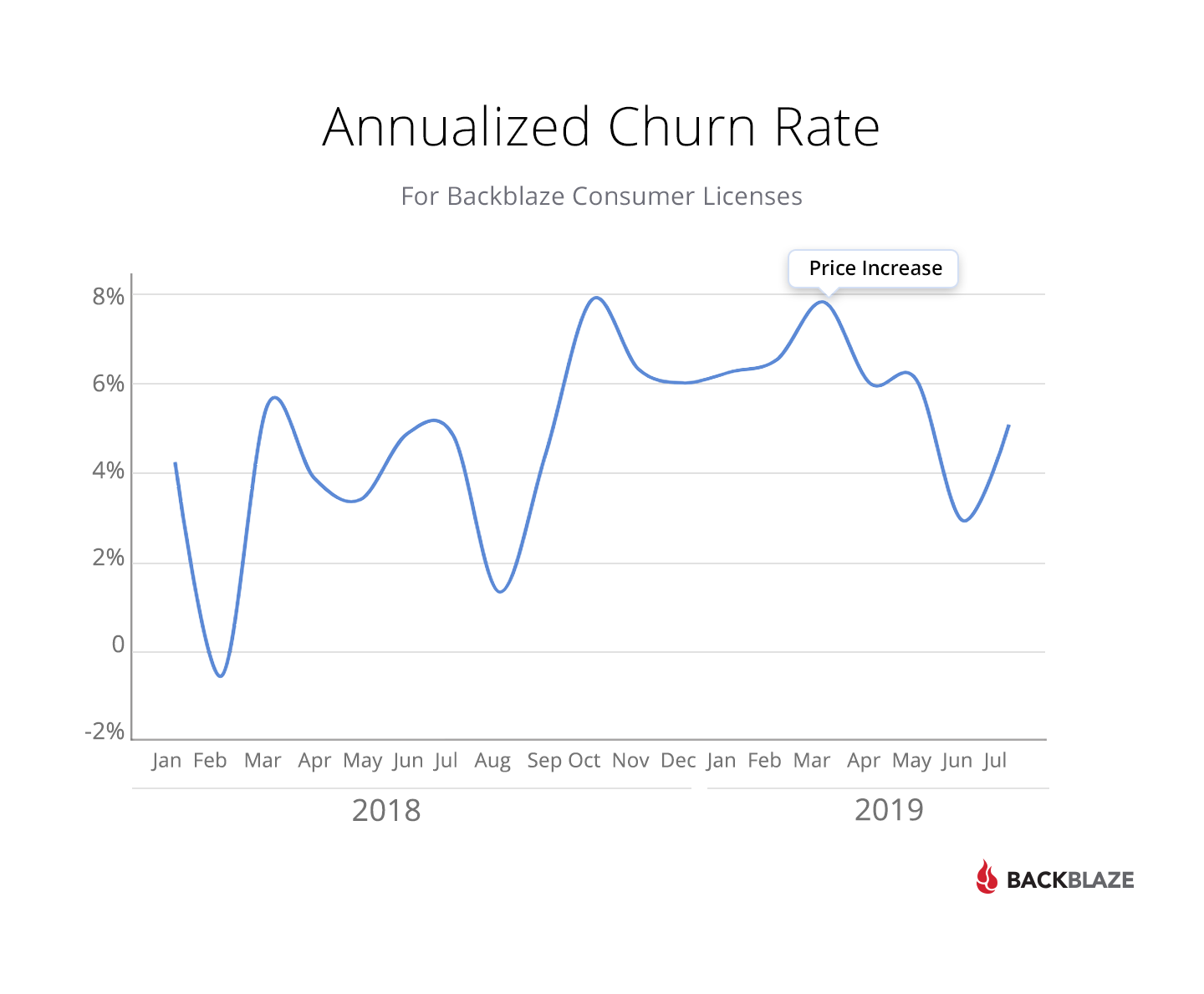
New Customer Acquisition
People leaving the service after you increase prices is only half of the equation. The other half lies in your new customer acquisition. Due to the market having competition, raising prices can cause prospective customers to look elsewhere when comparing products. This number was a bit hard for us to calculate since the year prior our biggest competitor for our consumer service went out of business. The best comparable we had was to look at 2017 versus. 2019. We went back to 2017 to look at the historical data and found that even with the increase, and six months afterwards, two year growth rate of our Personal Backup service was a healthy 42 percent.
Lessons Learned From Raising Prices
We learned a lot during this whole process. One of the most important lessons is treating your customers well and not taking them for granted. At the outset we’d sometimes say things like, “it’s only a dollar, who is going to care,” and we’d quickly nip those remarks in the bud and take the process seriously. A dollar may not seem like much, but to a lot of people and our global customers, it was an increase that they felt and that was evidenced in the churn going up by 7 percent.
Some might think, well a 7 percent increase in churn isn’t so bad, you could have raised prices even more, but that’s the wrong lesson to take away. Any changes to the plan we had in place could have yielded very different results.
Extensions
The extension program was a hit for our existing customers and a welcome option for many. Taking the time to build it resulted in over 30,000 Backblaze Personal Backup accounts buying extensions, which resulted in about $1.8M in revenue. There is a flip-side to this. If those 30,000 accounts had simply renewed at the increased price, we would have made $2.2M, resulting in $366,000 of lost revenue. But that’s only if you assume that all of those customers would have renewed. Some may have churned, and by buying an extension they signaled to us that they were willing to stay with us, even after the price increase goes into effect for them.
As a customer, def happy with the way you handled this. Appreciated the opportunity to buy an extension at the old pricing, comms was clear & direct, and the increase is reasonable. Cheers!
— Andrew Ferguson (@warandpeace) February 13, 2019
Being Engaged Helps
Having a good foundation of community and an open dialog with your customers is helpful. When we made the announcement, we weren’t met with the anger that we were somewhat anticipating. In large part this was due to our customers trusting us, and knowing that this was not something we were doing because we simply wanted to make a few extra bucks.
When your community trusts you, they are willing to hear you out even when the news is not great. Build a good rapport with your customers and it will hopefully buy you the benefit of the doubt once or twice, but be careful not to abuse that privilege.
Over-Sharing Helps
Similar to having a good community relationship, explaining the why of what is happening helps educate customers and continues to strengthen your connection with them. When I was on reddit and in the blog post comments discussing the price increase, the people on reddit and on our blog who have grown accustomed to our answering questions were comfortable asking some pretty hard ones, and appreciated when we would respond with thoughtful and long-form answers. I cannot stress enough how much we enjoy the conversations we have on these platforms. We learn a lot about who is using Backblaze, what their pain points are, and if there’s something we can do to help them. These conversations really do affect how we create and consider our product roadmap.
So many companies raise their prices chasing profits, keeping it on the low, so it was refreshing to get an email from @backblaze explaining why they have decided to increase theirs for the first time ever – transparent, decent, fair https://t.co/TDG5mknSLp #howbusinessshouldbe
— Darren (@Darren_Ware) February 12, 2019
Final Thoughts on Raising Prices
Rarely does anyone want to increase their prices — especially when it affects customers who have been with them for a decade. Many companies don’t want to discuss their decision making process or playbooks, but there are a lot of organizations that face the need to raise prices. Unfortunately, there are few resources to help them thread the needle between something they have to do, and something that their current and future customers will understand and accept.
I wanted to share our journey through our price increase process in hopes that people find it both informative and interesting. Thinking about your customers first may sound like a trope, but if you spend the time to really sit back and consider their reactions and what you can do as a way to thank your existing customers or clients, you can be successful, or at the very least mitigate some of the downside.
If you’ve ever raised prices at your company, or have examples of companies that have done a great job (or a bad job), we’d love to hear those examples in the comments below!


